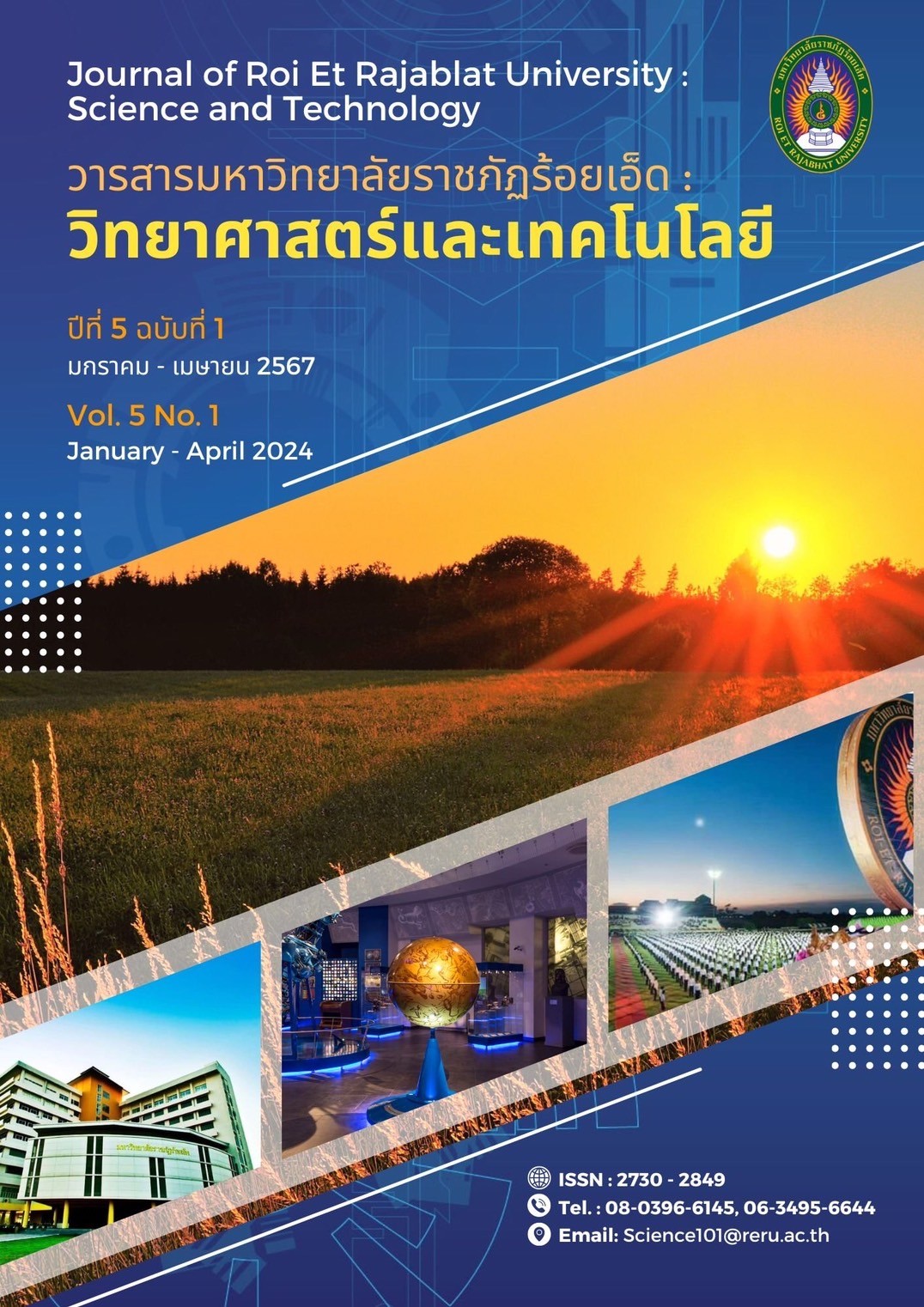ฤทธิ์สารสกัดดอกและใบกรุงเขมาต่อการฆ่าและยังยั้งการกินของเพลี้ยอ่อน
คำสำคัญ:
เพลี้ยอ่อน, กรุงเขมา, สารสกัดจากพืช, การยับยั้งการกิน, การไล่บทคัดย่อ
เพลี้ยอ่อนดูดกินน้ำเลี้ยงจากส่วนของพืช ทำให้ใบเป็นสีเหลืองและร่วงหล่น และขับมูลหวานปกคลุมบนใบพืชเป็นสาเหตุของโรคราดำ ส่งผลต่อกระบวนการสังเคราะห์แสงของพืช การเข้าทำลายในปริมาณมากส่งผลให้ผลผลิตลดลง การศึกษานี้มีวัตถุประสงค์เพื่อศึกษาฤทธิ์สารสกัดดอกและใบกรุงเขมา Cissampelos pareira L. ต่อการฆ่าและสารยับยั้งการกินเพลี้ยอ่อน โดยทดสอบประสิทธิภาพของสารสกัดหยาบจากกรุงเขมาที่สกัดด้วยเอทานอลในการเป็นสารฆ่าและสารยับยั้งการกินของเพลี้ยอ่อนถั่ว Aphis craccivora Koch. ที่ระดับความเข้มข้น 0.5, 1, 1.5 และ 2 เปอร์เซ็นต์ (w/v) เปรียบเทียบกับสารอิมิดาคลอพริดและตัวควบคุม ในสภาพห้องปฏิบัติการและกรงทดสอบ วางแผนการทดลองแบบสุ่มสมบูรณ์ (completely randomized design; CRD) ความเข้มข้นละ 20 ซ้ำ ผลการทดลองพบว่า สารสกัดกรุงเขมามีประสิทธิภาพฆ่าเพลี้ยอ่อนได้ แต่ประสิทธิภาพต่ำกว่าสารอิมิดาคลอพริด การทดสอบการยับยั้งการกินพบว่า สารสกัดกรุงเขมาทำให้การเข้าทำลายและระยะเวลาในการดูดกินบนใบครามของเพลี้ยอ่อนลดลง โดยความเข้มข้นของสารสกัดกรุงเขมาเพิ่มมากขึ้นส่งผลให้ระยะเวลาในการดูดกินพืชของเพลี้ยอ่อนลดลง
เอกสารอ้างอิง
Dancewicz, K., B. Gabrys, & M. Przybylska. (2011). Effect ofgarlic (Allium sativum L.) and tansy (Tanaceum vulgare L.) extracts and potassic horticultural soap on the probing and feeding behaviour of Myzus persicae (Sulzer, 1776). Aphids and Other Hemipterous Insects, 17, 129- 136. https://www.kul.pl/files/658/aphids17/12_Dancewicz_Gabrys_Przybylska.pdf
Insung, A. & J. Pumnan (2011). Control of the stored product mite, Suidasia pontifica Oudemans by essential oils of medicinal plants. https://www.nstda.or.th/brt/images/book/R652105.pdf
Auamcharoen, W. & K. Chumpooin. (2023). Contact and Fumigant Toxicity Activities of Psidium guajava L. Leaf Essential Oil against Dermatophagoides pteronyssinus (Trouessart). https://kukr.lib.ku.ac.th/db/kukr/search_detail/dowload_digital_file/382948/109245
Kaltenegger, E., B. Brem, K. Mereiter, H. Kaichhauser, H. Kahlig, O. Hofer, S. Vajrodaya, & H. Greger. (2003). Insecticidal pyrido [1,2-α] azepine alkaloids and related derivatives from Stemona species. Phytochemistry, 63, 803-816. https://pubmed.ncbi.nlm.nih.gov/12877922/
Lin, W., Y. Ye, & R. S. Xu. (1992). Chemical studies on new stemiona alkaloids, iv studies on new alkaloids from Stemona tuberose. Journal of Natural Products, 551(5), 571-576. https://pubs.acs.org/doi/pdf/10.1021/np50083a003
Tomorn, C., P. Penpo, K. Tanruean, T. Napiroon, K. Konkaew, N. Likhitrakarn, John Raymund D. Torres & P. Poolprasert. (2019). The potential herbal plant crude extracts as bioinsecticides for controlling Musca domestica larvae (Diptera: Mucidae). YRU Journal of Science and Technology. 4(2): 94-103.
https://li01.tci-thaijo.org/index.php/yru_jst/article/view/216647/158562
Prakash, A., J. Rao, & V. Nandagopal. (2008). Future of botanicalpesticides in rice, wheat, pulses and vegetables pest management. Journal of Biopestides, 1(2): 154–169. http://www.jbiopest.com/users/lw8/efiles/anand%20prakash_4_1.pdf
Zhou, L., S. Fang, K. Huang, Q. Yu, & Z. Zhang. (2015). Characterization of an epsilon-class glutathione S-transferase involved in tolerance in the silkworm larvae after long term exposure to insecticides. Ecotoxicology and Environmental Safety, 120, 20–26. https://pubmed.ncbi.nlm.nih.gov/26024810/
Phromsatha, R., S. Seema, S. Pandee, I. Pattanadee & U. Aunjitwatthana. (2015). Plant extract formulations from Stemona spp. and Acorus calamus L. for plant protection. 209-218. https://www.doa.go.th/research/attachment.php?aid=787
ดาวน์โหลด
เผยแพร่แล้ว
รูปแบบการอ้างอิง
ฉบับ
ประเภทบทความ
สัญญาอนุญาต
ลิขสิทธิ์ (c) 2024 คณะศิลปศาสตร์และวิทยาศาสตร์ มหาวิทยาลัยราชภัฏร้อยเอ็ด

อนุญาตภายใต้เงื่อนไข Creative Commons Attribution-NonCommercial-NoDerivatives 4.0 International License.
บทความที่ได้รับการตีพิมพ์เป็นลิขสิทธิ์ของคณะศิลปศาสตร์และวิทยาศาสตร์ มหาวิทยาลัยราชภัฏร้อยเอ็ด
ข้อความที่ปรากฏในบทความแต่ละเรื่องในวารสารวิชาการเล่มนี้เป็นความคิดเห็นส่วนตัวของผู้เขียนแต่ละท่านไม่เกี่ยวข้องกับมหาวิทยาลัยราชภัฎร้อยเอ็ด และคณาจารย์ท่านอื่นๆในมหาวิทยาลัยฯ แต่อย่างใด ความรับผิดชอบองค์ประกอบทั้งหมดของบทความแต่ละเรื่องเป็นของผู้เขียนแต่ละท่าน หากมีความผิดพลาดใดๆ ผู้เขียนแต่ละท่านจะรับผิดชอบบทความของตนเองแต่ผู้เดียว






